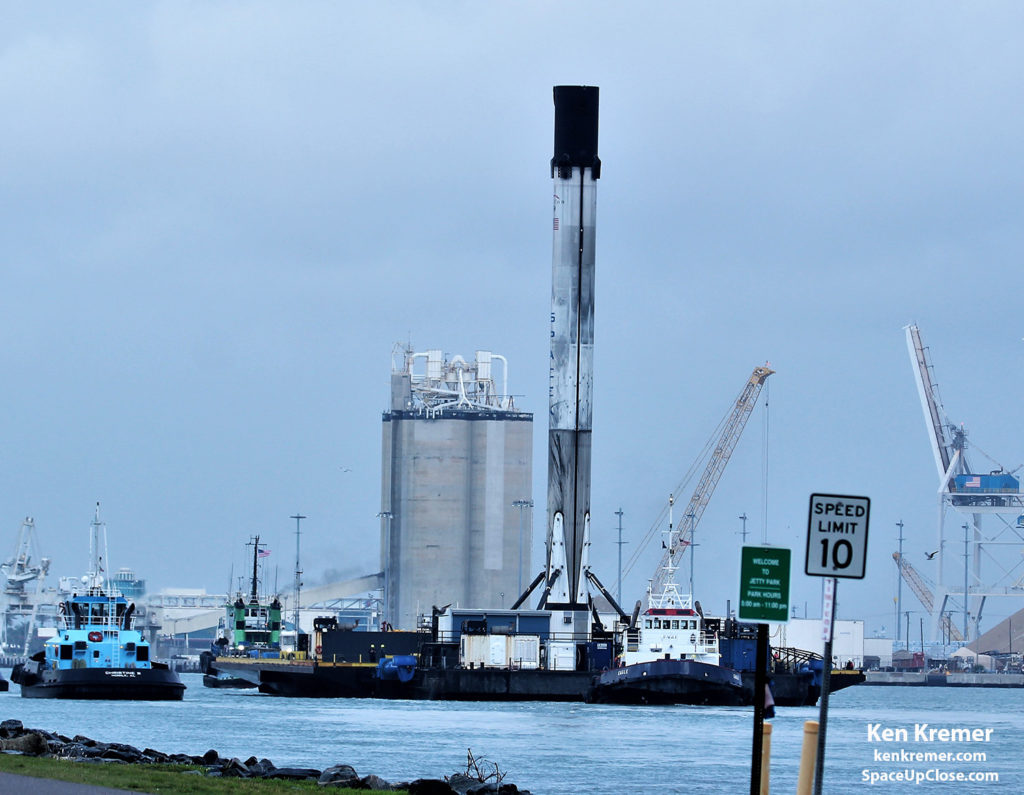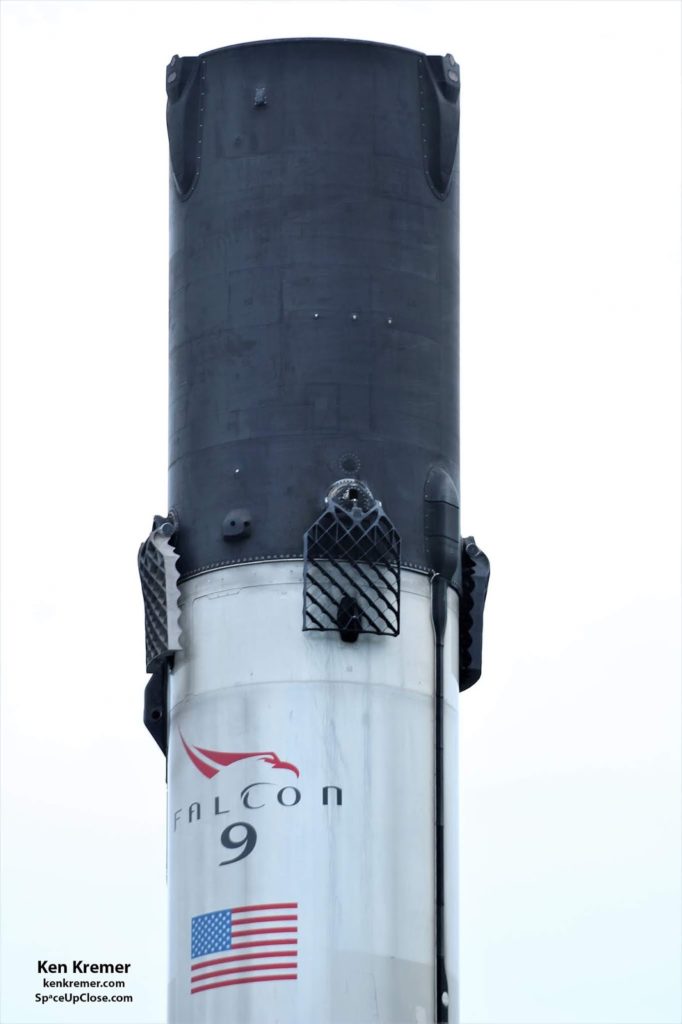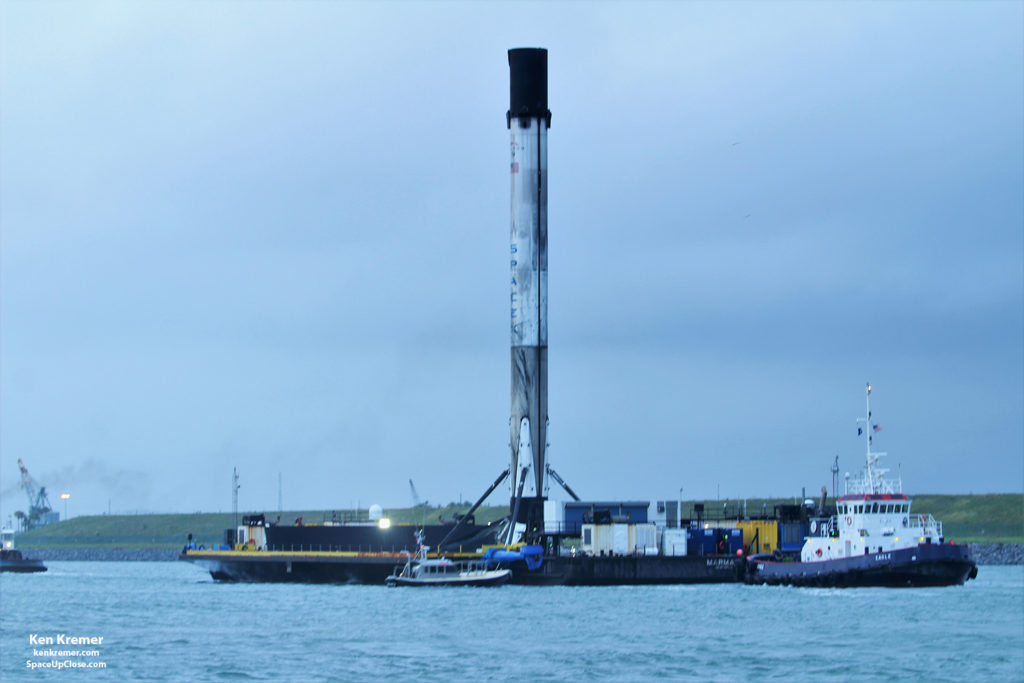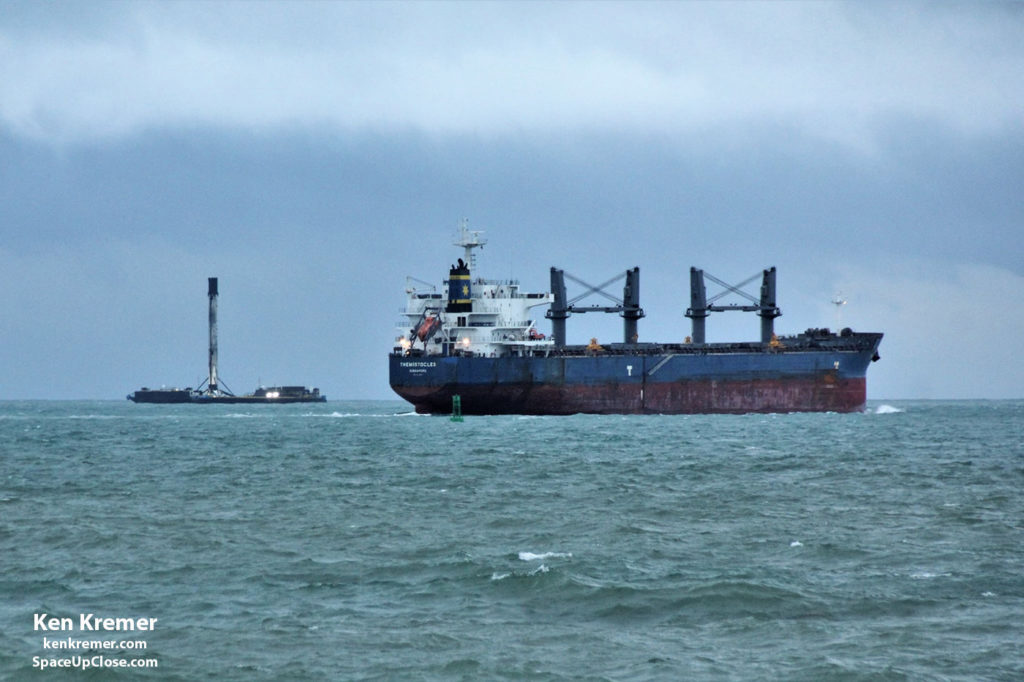— SpaceUpClose.com — 19 May 2018
PORT CANAVERAL, FL – Four days after the beautiful blastoff and subsequent
successful sea-based drone ship landing of the 1st upgraded Block 5
version of SpaceX’s workhorse commercial Falcon 9 rocket on Friday, May 11,
from the Florida Space Coast, the recovered first stage booster sailed superbly
into her home base at Port Canaveral at dawn Tuesday, May 15. UPDATED May 26
version of the Falcon 9 is also critically important to America’s future in
space because this US rocket will also soon launch US astronauts back to space and
the space station from US soil – hopefully later this year or early in 2019.
Enjoy our eyewitness
SpaceUpClose.com photo gallery of the Falcon 9 boosters ocean based platform return
to America’s Premier Spaceport!
are belatedly online here due to my need to travel later the same day to NASA’s
eastern Virginia shore launch base at Wallops Island to see the upcoming launch
of the Orbital ATK Antares rocket carrying the Cygnus cargo freighter on the
OA-9 resupply mission for NASA to the International Space Station (ISS).
Poor weather apparently
caused some changes to the boosters arrival time back into port – but it was nevertheless
a marvelous sight to behold a used rocket returning from the sea after its
maiden delivery trip to the edge of space and back.
Rough seas, chilly temperatures, completely overcast
skies, misty sprays and high winds greeted the small SpaceX fleet of tugboats, vessels
and a very special ‘drone ship’ as they carefully approached the mouth of Port Canaveral
and Tug Rachel towed the now ‘Flight-Proven’ first stage booster.
arrival from out at the end of the Jetty Park Pier as it approached around 7
a.m. EDT Tuesday morning May 15 – initially barely visible just as a distant
speck on the horizon and which gradually grew larger in appearance as it cruised
in closer from out in the Atlantic Ocean.
after successfully launching Bangabandhu-1 on May 11, the first ever
geostationary communications satellite for the nation of Bangladesh, the first
stage accomplished a precision guided soft landing onto the deck of the drone
ship named ‘Of Course I Still Love You’ or OCISLY for short, by reigniting a
subset of the 9 Merlin 1D first stage engines.
in the Atlantic Ocean some 400 miles (640 km) offshore of Florida’s East Coast
days before the launch.
white paint scheme made it easier to spot the booster far out at sea as well as
track it accelerating to space during the spectacular launch.
now rather sooty used booster with landing legs fully deployed was clearly
anchored to the surface of the drone ship – firmly clasped in the grip of the multipronged
robot nicknamed ‘Roomba’ with additional hold down support cabling to prevent it
from sliding overboard and crashing into the sea or tipping over and smashing onto
the deck amidst the ever constant and mighty ocean waves.
booster appeared to have touched down fully erect on the OCISILY platform at
sea. No tilt was visible to my eyes as had been the case on a few prior drone
ship recoveries and returns.
tug hauled Falcon 9 and OCISLY navigated majestically through the narrow channel
of Post Canaveral – seen by a small crowd of us. Due to the choppy waves, colder temps and
early hour there were only a smidgen of folks, boaters and pleasure craft there
to watch as it floated relentlessly by.
|
Attaching the heavily modified
interstage hoisting cap to 1st upgraded to Falcon 9 Block5 booster launched and recovered by SpaceX workers on the newly arrived OCISLY droneship floating into Port Canaveral, FL on May 15, 2018. Note the grid fins. Credit: Ken Kremer/kenkremer.com/spaceupclose.com |
OCISLY had arrived at its interior docking location nearer the commercial cruise
ship terminals.
to work and craned a new hi tech multifacted, bowl-shaped hoisting cap and extension
rod into place atop the black interstage and grid fins- that seemed to emit blue
laser lighting.
Roomba gripper and assorted cabling holding the stage in place atop OCISLY.
3 and 4 Falcon’s no crews were hoisted on cherry pickers to the top to assist
in bolting the heavily modified hoisting cap firmly in place. It was apparently equipped
with self-latching bolts/guide mechanics that obviated the need for work crews
to manually join and/or guide it in place.
went much faster than for prior booster recoveries.
a.m. the booster went airborne for a second time !
Workers hoisted the Block
5 Falcon 9 first stage off OCISLY, methodically rotated it around and then
swung it over and on to a mounting pedestal positioned on the ground station
leased by SpaceX at Port Canaveral.
offloading and craning operation took about 20 minutes to hoist Falcon 9 off
the drone ship and firmly place it on the circular pedestal.
remove the 4 landing legs.
Elon Musk had explained at a prelaunch briefing, the legs were not simply retracted
– which would have saved considerable time and effort.
leg was removed piecemeal – akin to an insects dissection – about two days
later.
booster was lowered horizontally with attached cables and placed onto the multi-wheel
transporter for shipment back to SpaceX hangar processing facilities on the
Kennedy Space Center and Cape Canaveral Air Force Station.
 |
|
Welcome to Jetty Park ..
Speed Limit 10. Recovered SpaceX Falcon 9 from Bangabandhu-1 launch floats by Port Canaveral, FL greeting on May 15, 2018. Credit: Ken Kremer/kenkremer.com/spaceupclose.com |
Musk said at the media
briefing that this particular maiden Block 5 would be at least partially disassembled,
so that engineers can conduct a rigorous inspection of the entire booster from
top to bottom – to determine the fate and state of the numerous upgrades and manufacturing
and assembly improvements and evaluate whether they performed as expected or if
any changes are required.
lift off again in a few months with a new customer.
9 Block 5 model is designed for 10 launch recycles with very minimal maintenance
in between, Musk stated.
ULA, Boeing, Lockheed Martin, Orbital ATK and more space and mission
reports direct from the Kennedy Space Center, Cape Canaveral Air Force Station,
Florida and Wallops Flight Facility, Virginia.
Earth and Planetary science and human spaceflight news: www.kenkremer.com –www.spaceupclose.com –
twitter @ken_kremer – ken
at kenkremer.com
for sale – contact Ken if interested














